When you’re producing marketing content, there are a lot of factors to consider. One of the most important is how your publications will perform on search engines. This dictates how easily people will find your articles, whether or not they will click on them, and even what topics you should cover. As such, it’s essential that you use every tool at your disposal to ensure that your content is optimized for search engines.
There are many approaches to ensuring that your articles and blogs are visible and engaging for your intended audience. However, one strategic consideration that doesn’t get as much attention is the People Also Ask feature on Google.
So, let’s go over what this tool is, how it works, and how it should impact your marketing content.
Key takeaways on People Also Ask (PAA)
The article discusses the People Also Ask (PAA) feature on Google search and its impact on marketing content. Here are five key takeaways:
- People Also Ask is a feature on the Google search engine that lists additional questions related to a user’s query, providing an accordion list of questions other people have asked about the entered search.
- PAA questions are primarily determined through machine learning that observes user tendencies and draws connections between different topics and search questions.
- Google’s People Also Ask related questions depend on how common the original search is, the connections to other queries identified by the search engine, and the popularity of those related questions.
- Benefits of People Also Ask include greater visibility, double-ranking opportunities, and the ability to guide future content creation.
- To optimize content for People Also Ask, one can respond effectively to user interests, adapt existing content to better fit changing questions, and check what questions relate to their topic, among other things. Additionally, there are several research tool options, such as SEOwind, Semrush Keyword Magic Tool, KWFinder, and Ahrefs Keyword Generator.
What is People Also Ask?
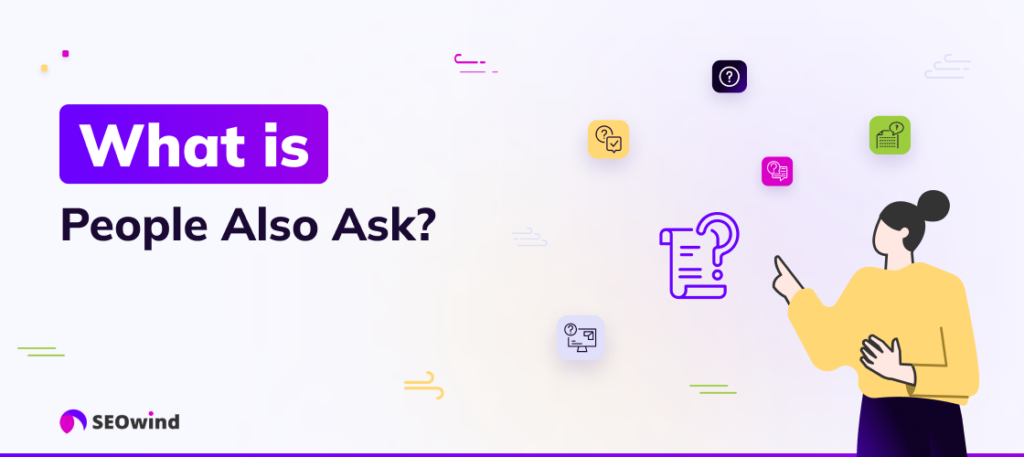
Whenever you launch a Google search, what is your primary interest? Typically, users are most interested in the results on the front page, which ideally answer your primary question. But another feature on the front page is incredibly useful not only for your everyday Google user but also for marketing leaders: the People Also Ask (PAA) box.
This is an additional tool that lists additional questions related to a user’s query. Specifically, People Also Ask provides an accordion list of questions other people have asked about your search entry. When a user clicks on one of these questions, Google provides a snippet answer as well as a link to the source page. In addition, that initial click triggers the dynamic addition of new questions to PAA boxes.
With this tool, Google ensures that its users find more than resources that directly respond to their queries. They will also discover questions people ask that are relevant to their interests and additional links to check out.
Where do PAA questions come from?
So, how does Google determine what people also asked and populate this box? Primarily through machine learning that observes user tendencies and draws connections between different topics and search questions. Based on this understanding, the search engine creates a list of the questions people also ask and relevant resources.
But where do the snippets come from? Google draws from resources that rank for these alternative questions, though it draws from more than just the front page. According to Devrix, As long as the content is high-quality and relevant to the question, the search engine can draw from the second or third page for its PAA questions.
What’s particularly interesting to note is what happens when the same question appears in different SERPs. Though the original query might change, Google’s People Also Ask will always use the same resource for the related question. As a result, if the search engine identifies a particular answer from a given website, this resource will reappear every time the question is featured in the questions tool.
What queries trigger People Also Ask questions?
In theory, any query can trigger the Google People Also Ask box to appear. This depends on how common the original query is and how many connections to other questions have been identified. This is also determined by a search engine algorithm that determines the most popular search terms.
So, the appearance of Google’s People Also Ask related questions depends on how common your original search is, the connections to other queries identified by the search engine, and the popularity of those related questions.
How People Also Ask works
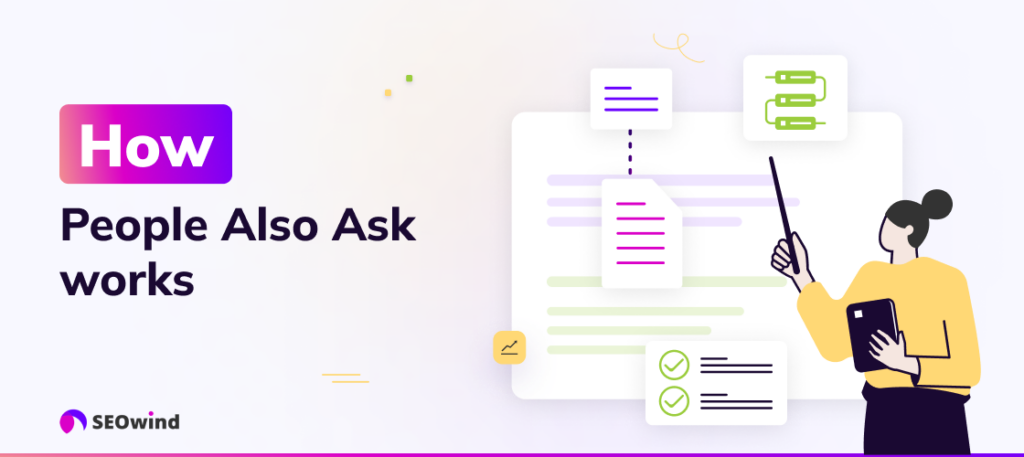
Before winning over this potent piece of Google’s algorithmic mystery, we need to unravel ‘Google People also ask’ – a significant player amidst question-based keywords and user searches in today’s digital world.
Explore the Algorithm Behind People Also Ask Feature
Google aims to understand the intent behind queries and facilitates better answers through contextualization. When we type a query into the search bar, after displaying core results based on that keyword search, Google broadens the horizon by showcasing related questions other users have asked through People Also Ask (“PAA”).
The structure of PPA entails expandable boxes holding answers sourced from various websites. Once the box is expanded, similar questions are added below it, creating an endless cascade of information-related threads.
Discover How Questions are Generated and Displayed in Search Results
What exactly does it take into account? This begins with the original query that launched the search, but it goes far beyond that. Google’s algorithm also considers your location, device, search history, and web browsing history. Last but not least, the search engine factors in the content of the SERP. This algorithm runs constantly and updates in real time to reflect the latest queries. It also represents Google’s latest work, as the company constantly makes tweaks and improvements.
Learn About Query Expansion and Related Searches
As digital marketers, understanding ‘query expansion’ is critical. It’s the practice of broadening a search by exploring related questions and keywords – exactly what PAA does.
If a user seeks “how to optimize for people also ask,” PAA might prompt:
- What is People Also Ask?
- How do I tailor content for People Also Ask?
The bottom line is that every question in PAA aids in directing users down rich discovery pathways, leading to potentially fruitful connections with your well-positioned content.
In the upcoming section, we expose tips and strategies on creating and optimizing content to feature prominently within ‘People Also Ask.’ Stay engaged as we unravel ways to place your answers at the forefront of these discerning queries.
How does Google’s People Also Search For work?
Of course, PAA isn’t the only Google feature that goes underappreciated. Let’s take a short break to discuss the People Also Searched For box.
Imagine that you’ve just searched “google ask question” in Google. After reviewing the results, you find a link that seems to answer your question. However, once you’ve read for a bit, let’s say that it turns out to be less valuable than initially thought. So, you navigate back to the search results page, only to find a new box has appeared beneath the link you originally clicked on.
This is the “People also search for” function, which is powered by Google’s related search algorithm. This takes multiple factors into account when determining which queries are related to the main query and the resource with which you’ve just engaged.
Benefits of Appearing in People Also Ask
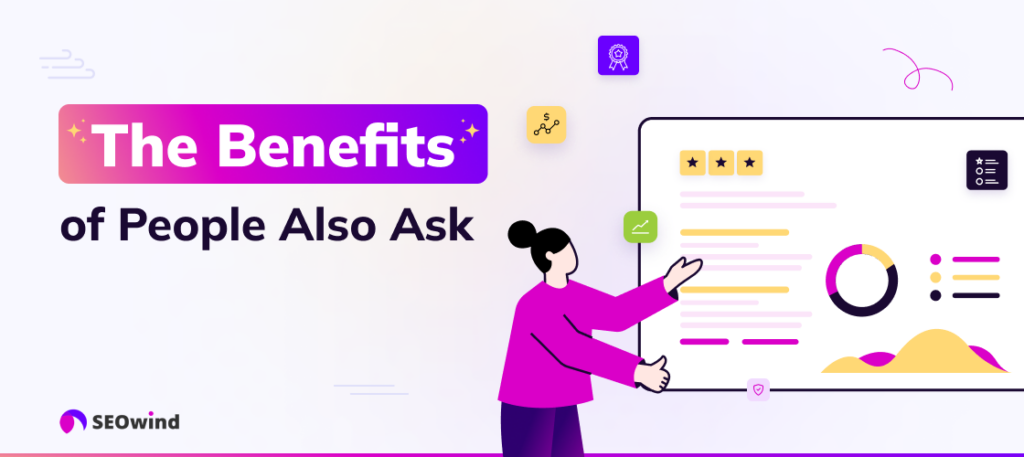
It’s all well and good to know how these various Google tools operate, but what good do they do you and your business?
Greater visibility
The presence of PAA boxes has significantly altered the landscape of SERPs. These expandable question boxes often appear near the top of search results, pushing organic listings further down the page. This change in SERP structure means that optimizing for PAA can be crucial for maintaining visibility, especially for competitive keywords where traditional organic rankings might be challenging to achieve.
Double ranking opportunities
But ranking for People Also Ask is not the extent of what you can achieve. In fact, unlike other featured snippets, this tool allows you to double-dip. You can rank on the first of Google and within the PAA box on the same page. As such, if your content appears in this box as part of a search for questions, users have two chances to click on your link.
Positive Impact on Click-Through Rates (CTR)
PAA boxes can have a dual effect on click-through rates. On one hand, they provide quick answers that might satisfy a user’s query without the need to click through to a website, potentially reducing CTR for organic listings. However, for users seeking more in-depth information, PAA boxes can serve as additional entry points to your content, potentially increasing overall click-through rates if your content is featured in these boxes.
Guide future content creation
The benefits extend beyond improving PAA SEO and driving engagement. You can use the related questions to help develop new content ideas that will appeal to your audience. The People Also Ask tool offers an issue way to discover what people are asking about. By then following up on this knowledge to develop content that shares themes, you build topical authority. In this way, it becomes easier for Google to trust you on a specific topic, improving your chances of having content featured and ranking higher.
How to Optimize for People Also Ask
All of this might lead you to ask exactly what is PAA in SEO? What role can it play and how should you adjust your content to take advantage of it?
Used properly, the People Also Ask tool can make an impact at various stages of your marketing processes.
Respond more effectively to user interests
First, as we’ve already mentioned, you can use this tool to learn what people are asking on Google. This can then guide an adjustment of your content themes and ideas based on questions you might not have otherwise considered. By developing new content that responds to the questions people also ask Google, you ensure relevance for your audience.
Adapt existing content to better fit changing questions
But you can also adjust existing content to perform better while keeping PAA in mind. Take the related queries and add an FAQ section to an article that answers them. As a result, you’ll cover additional ground without having to start from scratch while expanding the page’s relevance for Google. Using PAA can be a great way for creating long-form content.
Check what questions relate to your topic
Finally, before you start writing, a bit of PAA research can flesh out your briefs and content outline. By responding to the questions people are asking on Google, your content becomes more targeted and a better source for snippets.
How to rank for People Also Ask
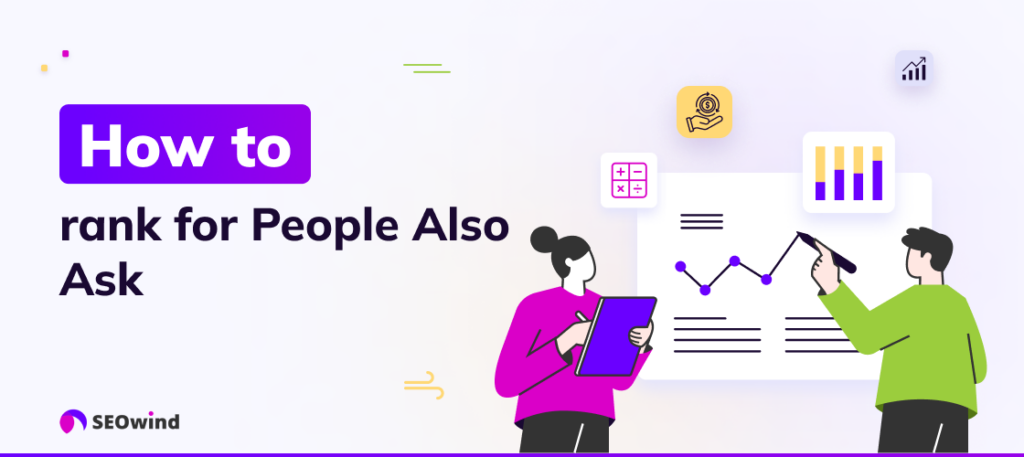
If People Also Ask can make it easier for users to find your content, then how do you rank for it?
1. Identify questions related to the initial search
The first step is to find questions that users want to be answered after an initial query on a subject. Once you know what people ask when looking into your topic, you’ll have a better idea of what content to create. And that material is then more likely to be targeted by PAA.
Keep in mind that any properly optimized content will need to directly answer the question it addresses. By doing so, you ensure that Google will recognize your website as a valuable response to common questions.
2. Check the PAA results for your keywords or subject
One way to learn about related topics and queries is to simply click through the PAA box. When you enter keyword questions into Google, the tool will naturally indicate what other users want to know. But if you’re looking for more in-depth data and understanding, use a Google research tool. Some solutions out there will identify questions users are asking and related topics they’re searching for.
3. Do your research
Really at the end of the day, publishing content that will appear in People Also Ask requires knowledge. Whether you do the necessary keyword research yourself or use a keyword questions tool, you’ll need to properly understand Google’s People Also Ask related questions to produce content that suits it.
4. Optimize content to answer specific questions from People Also Ask
Google’s algorithm loves specificity. By optimizing your content around specific question-based keywords, which are found in the People Also Ask section, you’re aligning it with exactly what users want to know about a particular topic.
Make sure your answers aren’t just generic statements but provide real value and thoroughly address users’ inquiries. When you do this well enough, Google will see it as a helpful resource and may reward it with improved rankings.
5. Consider formatting and structure to enhance visibility in search results
The way you format your content can greatly influence whether or not it gets featured in the coveted places of SERPs, including the PAA boxes.
Here are some key points regarding formatting:
- Use header tags strategically: Break down lengthy posts by using H1-H6 tags judiciously.
- Listicles are winners: Provide information as numbered lists (where appropriate). This catches attention and encourages rankings.
- Bullet Points work, too: Bulleted lists offer easy readability and enhance article flow.
These tactics ensure that readers (and search engines) can understand the main points of your content at a glance.
6. Take advantage of the expandable question boxes to provide valuable information
The unique feature in Google’s People Also Ask is the ‘expandable box’. Every time you click on a question, new related questions are generated. It means more potential spaces for your content, provided it answers those newly expanded queries.
Routinely check these expanding boxes within your industry or niche. They can serve as an amazing resource for updated relevant keywords and trendy topics that you can incorporate into your current and future content.
7. Use enticing headlines and concise answers to capture user attention
First impressions are everything online. Your headline must be engaging enough to woo readers, while keywords ensure that search engines find the piece relevant.
In addition, since space is at a premium in PAA boxes, ensure that your answers are concise yet adequately informative right from the outset.
8. Utilize featured snippets to enhance visibility within People Also Ask Section
Featured snippets – informational text boxes that appear above SERPs – provide quick answers to users’ questions without them needing to click on web pages. They’re like free advertising for websites lucky enough to claim them!
If you get a snippet featured, there’s a high chance your website will also feature in the PAA section since both have similar criteria, i.e., answering specific user inquiries succinctly yet thoroughly. Optimize for this by structuring your content with unique insights around focused keywords and providing clear answers up-front.
Optimizing your site for PAA involves strategic planning and careful research, followed by creating captivating and value-packed content that thoroughly addresses queries about hot-button topics in your industry. Remember always: Google appreciates quality content that fulfills its main aim – that is, delivering accurate information quickly – to answer its users’ questions earnestly well.
Aligning your content with your audience’s interests
Now, what do you do if you simply are not getting the traffic you expect?
When that happens, it’s time for introspection. It’s not your audience’s fault if they don’t engage with your content. As a marketer, it’s your responsibility to publish material that will attract users.
But how do you accomplish this?
Too often, marketers will focus too much on their own goals and not enough on their audience’s interests. People Also Ask helps to put you in the average user’s shoes by revealing the search engine questions you should focus on.
Once you have that foundation, it’s time to figure out new types of content you could make to bring people to your website. But as discussed earlier, there’s no reason not to go back through your existing content catalog. You can make content updates in many ways, including adding sections, changing headers, and even writing an FAQ section. All of this should directly respond to the questions that users search for in connection to your primary query.
Research tool options for People Also Ask
AnswerThePublic is one of the more popular tools out there for finding keyword questions. And while it does its job admirably, it is far from the only option out there. Here, we’re going to cover a few AnswerThePublic alternatives that you can consider.
SEOwind
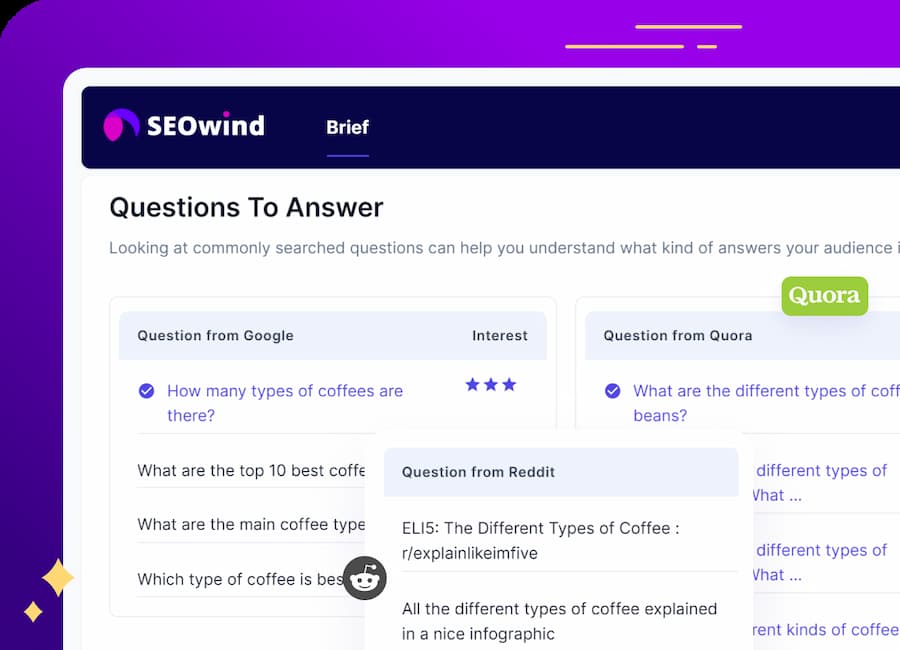
If you are looking for keyword questions to include in your content brief or for optimizing content, then SEOwind is a good choice.
As a part of analyzing SEO data, SEOwind collects questions on People Also Ask, as well as ones asked in Quora and Reddit. This will help you have all the data regarding the target keyword in one place.
If you would like to find out how to create content brief with SEOwind using People Also Ask questions got to our Guide: How to create a content brief with SEOwind? Best practices in SEOwind
Semrush Keyword Magic Tool
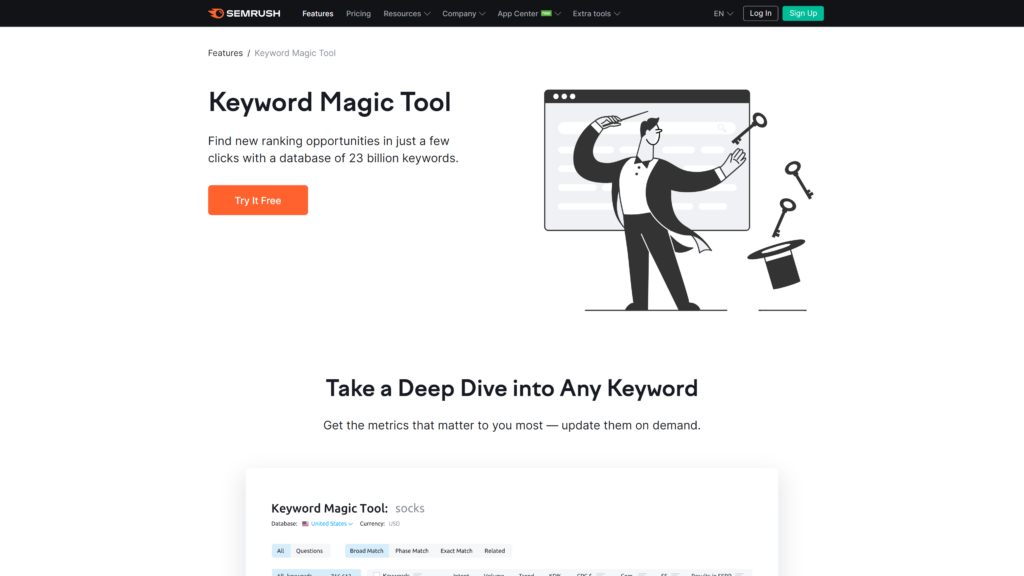
This Answer the Public alternative draws upon 21 billion keywords taken from 142 geodatabases. Semrush provides detailed information about search volume, cost per click, and competition activity for any given keyword. By entering a few related words or phrases related to your topic, it generates an extensive list of keywords that you can then filter however you’d like.
KWFinder
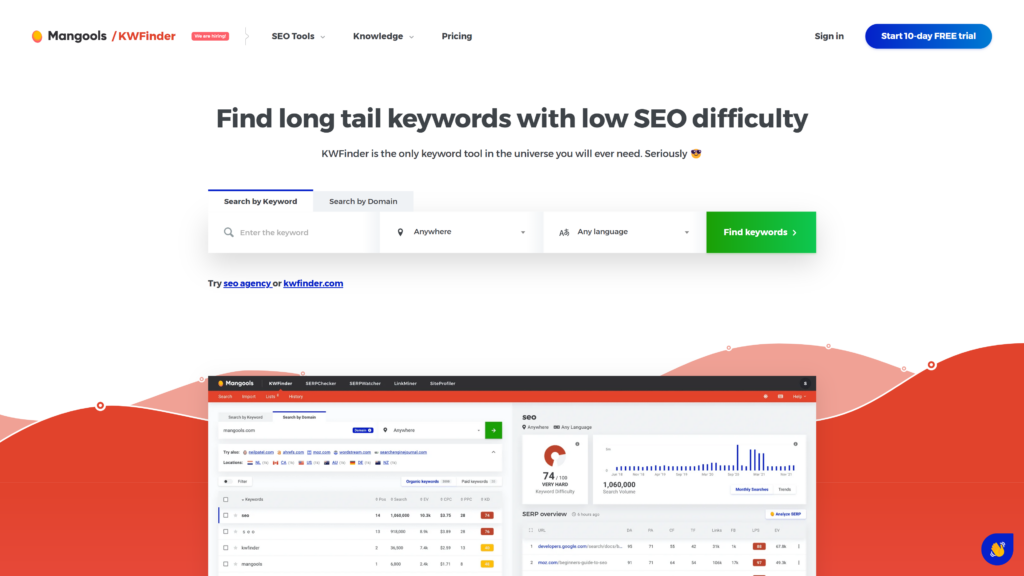
In KWFinder, we have a tool that focuses specifically on helping its users find low-competition keywords. In addition to other standard criteria, the tool identifies a difficulty score for each option. KWFinder also lists all the relevant question keywords, the trends associated with different queries, and other key information that you need to understand the connections between different questions.
Ahrefs Keyword Generator
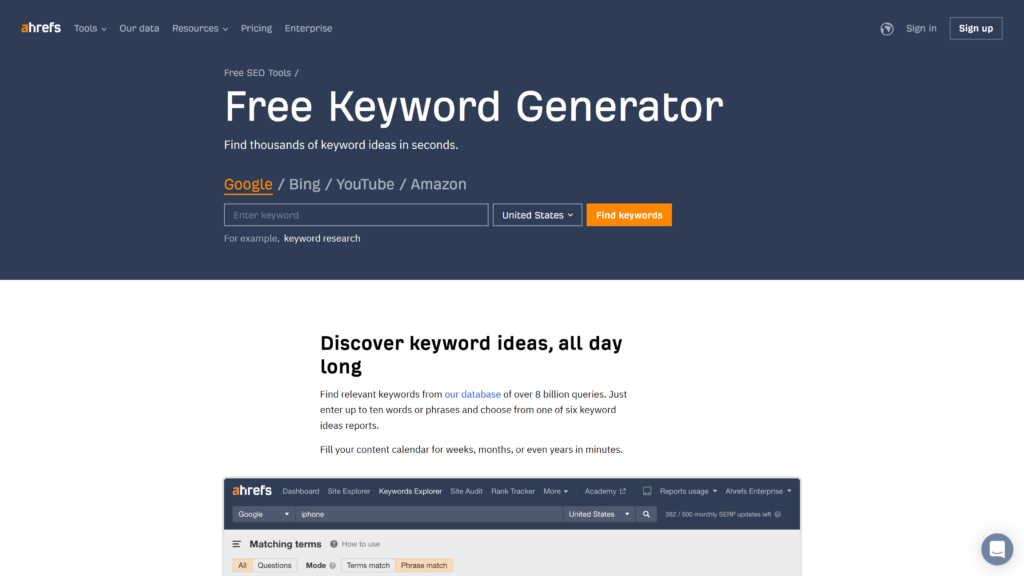
Our final alternative suggestion primarily helps by discovering keywords that are relevant to your primary topic. With Ahrefs, you can choose your desired search engine and database. Afterward, the research tool will gather a list of question keywords, keyword difficulty, and search volume.
People Also Ask is an incredibly useful tool for identifying underlying audience intentions when searching for a topic on Google. If you comprehend and use it properly, it can play a key role in guiding the evolution of your marketing strategy!
How to Use People Also Ask for Content Strategy
Identifying Content Gaps
One of the most valuable aspects of People Also Ask is its ability to reveal content gaps in your existing strategy. By analyzing the questions that appear in PAA boxes related to your target keywords, you can identify topics that your audience is interested in but that you haven’t yet covered. This insight allows you to create new content that directly addresses these user queries, potentially capturing more organic traffic and improving your overall search visibility.
Developing FAQ Sections
PAA questions can serve as an excellent foundation for creating comprehensive FAQ sections on your website. By incorporating these common questions and providing detailed answers, you not only improve your chances of appearing in PAA boxes but also enhance the overall user experience on your site. This approach can lead to increased time on the page, lower bounce rates, and potentially higher conversion rates as users find the information they’re seeking directly on your site.
Monitoring and Analyzing the Performance of People Also Ask
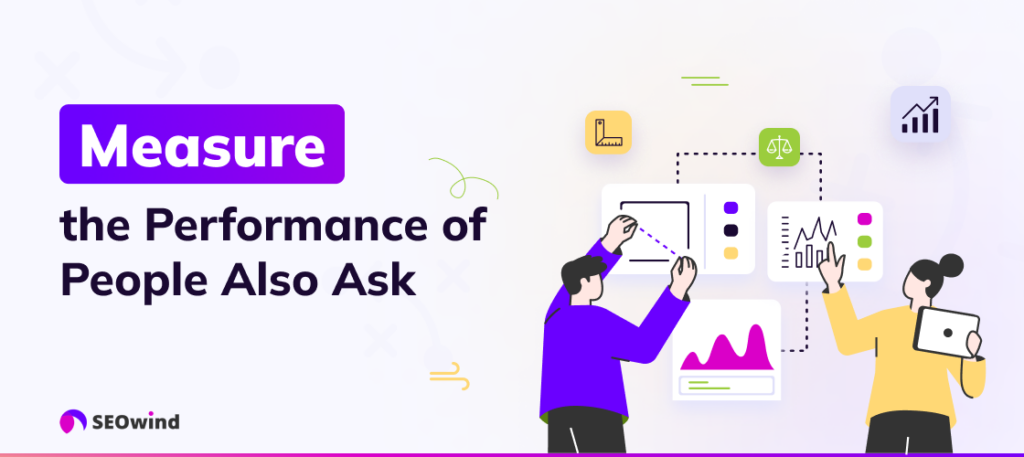
Tracking and evaluating your performance in Google’s People Also Ask (PAA) section is essential. By understanding your audience’s behavior, you can optimize your content to rank higher and drive more organic traffic to your website.
Learn How to Track Impressions, Clicks, and Conversions from the Feature
Google Search Console is a useful native tool that can help you monitor how PAA questions drive traffic to your site. Tracking parameters such as
- impressions (how many times users saw these questions),
- clicks (how often users clicked on them), and
- conversions (visitors who performed targeted actions on your website after clicking through PAA),
allows you to measure success and refine strategies for optimal impact.
Here are some steps you can follow:
- Go into Google Search Console and click “Search Results” under “Performance.”
- Enable all metrics for total clicks, total impressions, average CTR (click-through rate), and average position.
- Filter for queries containing your tracked keyword or question-based keywords.
Combining this data with user feedback or direct observations gives a more holistic view of the “experience” subscribers have when interacting with PAA-driven content.
Remember that while every click counts, what truly matters at the end of the day is conversion – whether visitors engage in meaningful activities like making a purchase, signing up for a newsletter, or filling out an inquiry form.
Use Analytics Tools to Measure The Impact of People Also Ask on Website Traffic
Several analytics tools, like Semrush, Ahrefs, Moz Pro, are available at our disposal to assess further how People Also Ask influences web traffic patterns.
These platforms deliver comprehensive SEO insight beyond raw data by providing key information – domain authority ranking updates, external links pointing back to published articles, and estimated number of visits per page based on search query and position, among many others.
It’s beneficial to dive deep into these analytics tools. Use them to determine how the presence in Google PAA impacts your site’s visibility and overall traffic.
For example, if you notice a significant increase in organic traffic every time a piece of content appears under PAA, it’s safe to assume that this feature contributes considerably to your site’s SEO strategy.
By continually monitoring and evaluating People Also Ask performance, we can stay ahead of fleeting trends while consistently delivering what our audiences genuinely seek – trustworthy answers from an authoritative source. By leveraging the power and wisdom wrapped within questions people ask through Google’s PAA, we transform curious browsers into loyal followers who trust us as their principal information source on the web.
“A statistical analysis, properly conducted, is a delicate dissection of uncertainties, a surgery of suppositions” – M. J. Moroney
This quote underscores the importance of careful and nuanced analysis when working with PAA data. It’s not just about the numbers, but about understanding the context and implications behind them.
“Without data, you’re just another person with an opinion” – W. Edwards Deming
In the context of PAA optimization, this quote reminds us of the critical role that data-driven decisions play. Relying on concrete data from PAA performance metrics rather than assumptions can significantly improve your SEO strategy.
Common Mistakes When Optimizing for People Also Ask
When optimizing for PAA, avoid these common pitfalls:
- Focusing solely on short answers without providing context or depth.
- Ignoring the relevance of PAA questions to your overall content strategy.
- Failing to update your content as PAA questions evolve over time.
- Overlooking the importance of mobile optimization, as many PAA interactions occur on mobile devices.



